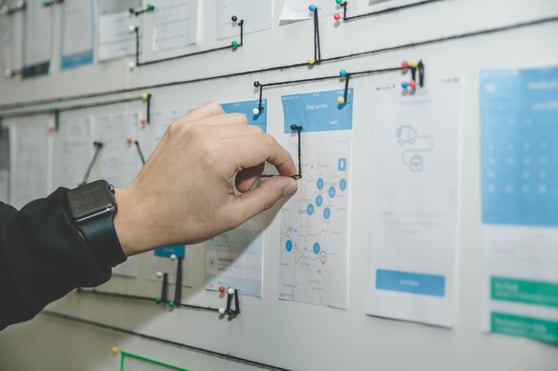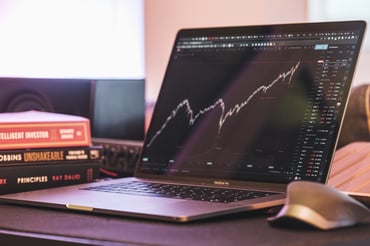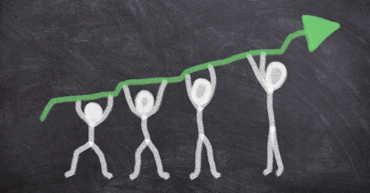This is the second blog post in HYPE's series on the ten most-often-asked questions about strategic foresight. The first post introduced the ten questions, and this post provides guidance, practical tips, and examples on how to get started with brainstorming the future of your market and develop foresight capability step-by-step.
Brainstorming the future of your market is as much about the future itself as it is about building foresight capability – the capability to anticipate and plan for the future. A business capability, such as foresight capability, can be understood to consist of processes, touchpoints, actors and their competences and behaviors, governance, data, and tools and technologies. Hence, foresight capability is about brainstorming the future of businesses while simultaneously developing and utilizing the capability to identify trends and interpret their meaning with a meaningful focus, together with customers and partners.
Here are the five steps to follow to brainstorm the future of your market.
1. Define what 'future of' you want to learn about and why
What do you want to learn about? What is “the future of” that you are pondering? How are you planning to utilize the understanding of your findings? Typically, the future that we are interested in is related to our business, industry, market, or broader operating environment. For example, a company in the food production market could ponder about the future of food or eating and subsequently about the changes in demographics and values behind consumers’ food choices, urbanization, climate change, regulatory changes, and technological advancements throughout the value chain.
That understanding could then be utilized from strategy creation to all things related to execution (e.g., organizational and business model development). Take the time to play with “the future of” alternatives that could scope the brainstorming activities. Different scopes will produce an understanding of varying depth and breadth for the future of your market: for a company in food production, the future of eating could represent a broader lens than the future of food and can better identify new business opportunities.
2. Get curious about what might be
Curiosity is the strongest power and mindset to harness when diving deeper into the identified scope – deeper into “the future of.” The scope will be your guide to identify trends (mega, macro, and micro), phenomena, weak signals, and uncertainties that could be relevant for anticipation and planning.
For someone just getting started with foresight, there are plenty of solutions available for trend identification and analysis as well as ready-made interpretations of different trends and phenomena in the form of scenarios. Those more advanced in foresight are often themselves trend curators, meaning that they gather stories and ideas and curate them to define and validate a trend for insight (see, for example, Rohit Bhargava’s Haystack method to learn more about trend curation).
“The future of” will be your guide to identifying the breadth of trends and the like. Your business, customers, customers’ customers, suppliers, and partners are the viewpoints through which to bring depth into foresight.
For example, a machinery supplier to pulp and paper companies might not emphasize the trend of sustainability, but looking at its customers and the end-users of the products might reveal the growing importance of supply chain transparency and the pressure to lower the CO2 footprint across the whole chain – viewpoints that are ultimately important for the product development decisions.
3. Interpret the trends and create alternative views of your market's future
Trends, phenomena, weak signals, and uncertainties can be interpreted individually or in tandem to understand their nature (e.g., an opportunity or a threat) or bring insight and inspiration to your innovation program. However, just focusing on individual trends can lead to cherry-picking those that are favorable to our future, or they can lead us to form a single-minded view of the future. Overall, to speak of the future in the singular is misconceiving. As we look ahead, there are always multiple futures that we can imagine and foresee. A trend might get weaker and stronger, and trends are regularly at interplay with one another.
"As we look ahead, there are always multiple futures that we can imagine and foresee."
One of the most often-used tools to create alternative views of the future is the scenario method. A scenario is a description of a possible future situation that develops from a chain of actions or drivers. By carefully selecting drivers (e.g., trends) that have relevance and meaning to the business as well as altering their magnitude, different scenarios start to unfold.
For example, a company operating in the built environment sector formed scenarios based on three key drivers: urbanization, climate change, and technological development. By altering the magnitude of these drivers, we created six scenarios that represented alternative views of what the future could be (e.g., urbanization: population concentrated in a few megalopolises; climate change: climate change has stopped; technological development: rapid development). The company used those scenarios to identify what kind of market needs (customer industries and geographies) might arise, what the potential solutions could be, and so on.
4. Brainstorm the future of your market together with customers and partners
Talking about the future – interpretations of trends or alternative views of the future – with actors outside of your organization helps in testing and enriching the interpretations and created scenarios. You can invite customers, customers’ customers, non-customers, suppliers, suppliers’ suppliers, and partners to participate in the discussions about the future. All players in your value chain or ecosystem can bring additional viewpoints to how they see trends and scenarios develop, market needs arise, and the business potential of possible solutions.
The most valuable discussions have taken place in workshops where customers and partners from different industries and markets have had the opportunity to familiarize themselves with the interpretations and scenario descriptions beforehand with the explicit assignment to come and enrich and challenge the views of the future of the market.
5. Develop foresight as a capability
As mentioned earlier, getting started with gaining more understanding about the future is as much about exploring the future as it is about building the capability to anticipate and plan for the future. Hence, instead of looking at foresight as one-off activities, foresight should be understood as a capability to be developed and utilized systematically.
All business capabilities – foresight capability included – consist of processes, touchpoints, governance, responsibilities and competences, data, tools and technologies. To develop a capability is to develop its building blocks.
The sections above have provided some examples of what the building blocks of foresight capability could look like. The table below offers a blueprint for the development of foresight capability.
| Processes |
The foresight process consists of identifying trends, phenomena, weak signals, and uncertainties, followed by interpreting their meaning and relevance to produce strategic insight. |
| Touchpoints |
The foresight process has touchpoints with all other processes that have to do with long-term planning and/or supporting the organization in developing its competitive advantage. |
| Governance |
Foresight has its management model (roles and responsibilities, incentives, forums, etc.), as well as it is integrated into the organization’s overall management model. Defining roles, responsibilities, and incentives related to foresight helps ensure enough attention is dedicated to foresight. Foresight can have dedicated positions (e.g., director of strategy, insight manager), or responsibilities can be divided into functional roles (e.g., head of HR, head of product development). Organizations must discuss and debate foresight across different forums to feed into processes that have to do with long-term planning. |
| Actors, responsibilities, and competences |
Internally, foresight can have dedicated roles or responsibilities divided into functional roles. Externally, customers, suppliers, partners, etc., should be involved in the foresight process. |
| Data and technologies |
Identification of trends, phenomena, weak signals, and uncertainties:
Interpretation of the meaning and relevance of trends, phenomena, weak signals and uncertainties, e.g., scenario analysis. |
How do you see your foresight capability and the maturity of it in light of the blueprint? Let us know in the comments below!
--
For software support, check out HYPE Strategy - Discover the gaps in your strategy and identify the trends, technologies, and organizations that can fill them.










